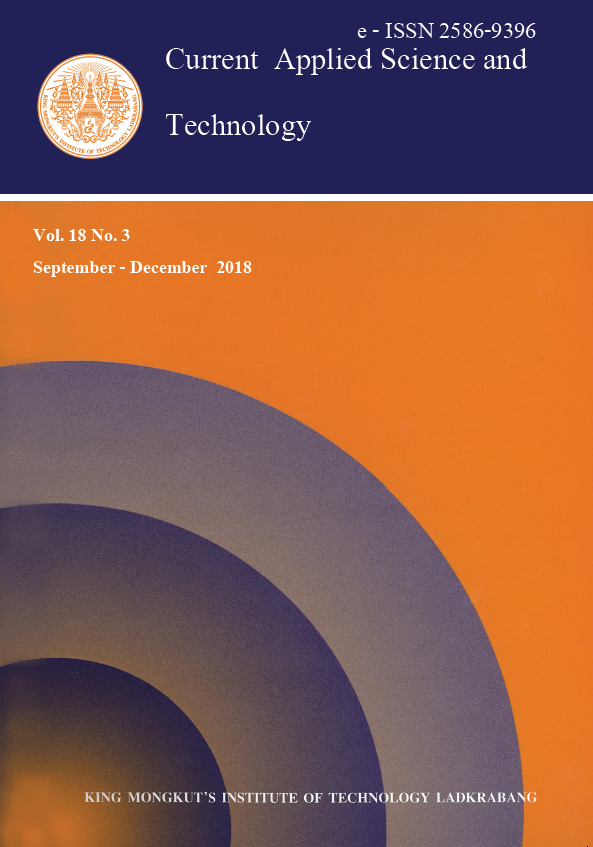Effect of Modified Molasses Carbon Filler on Mechanical Properties of Natural Rubber Vulcanizates
Main Article Content
Abstract
In this research, a possibility study was carried out on the utilization molasses, inexpensive by-product of the refining of sugarcane into sugar, as alternative filler in rubber. Liquid molasses was converted to powder form under the heating process. Molasses carbon powder (MCP) was finally obtained. As a result of percentage of carbon content in MCP, it was evident that MCP containing 64.5 percent of carbon. Interestingly, the MCP was rich in carbon as well as carbon black (CB) reinforcing filler in rubber. In order to enhance the mechanical properties of MCP filled NR vulcanizates, MCP was modified with a silane coupling agent such asbis (3-triethoxysilylpropyl) tetrasulfide or Si69. Thus, the present work aims to investigate the role of silane coupling agent on properties of NR vulcanizates filled with MCP. Modified and unmodified MCP was incorporated into the NR with loadings of 30 phr (parts per hundred of rubber) and also compared with CB. All of NR filled with carbon fillers were examined in the term of cure characteristics, tensile properties, tear strength and swelling resistance. From the results, it was observed that the cure times were decreased with the incorporation of silane modified MCP. In addition, torque difference, tensile strength, tear strength and swelling resistance of NR vulcanizates were improved.
Keywords: natural rubber, molasses, carbon black, silane coupling agent, filler
*Corresponding author: E-mail: bbiirrddtt@hotmail.com, thanunya@webmail.npru.ac.th
Article Details
Copyright Transfer Statement
The copyright of this article is transferred to Current Applied Science and Technology journal with effect if and when the article is accepted for publication. The copyright transfer covers the exclusive right to reproduce and distribute the article, including reprints, translations, photographic reproductions, electronic form (offline, online) or any other reproductions of similar nature.
The author warrants that this contribution is original and that he/she has full power to make this grant. The author signs for and accepts responsibility for releasing this material on behalf of any and all co-authors.
Here is the link for download: Copyright transfer form.pdf
References
[2] Waddell, W.H. and Evans, L.R., 1996. Use of nonblack fillers in tire compounds. Rubber Chemistry and Technology, 96, 377-423.
[3] Wolff, S., 1996. Chemical aspects of rubber reinforcement by fillers. Rubber Chemistry and Technology, 96, 325-346.
[4] Sobby, M.S., El-Nashar, D.E. and Maziad, N.A., 2003. Cure characteristics and physico mechanical properties of carbonized bamboo fibre filled natural rubber vulcanizates. Egyptian Journal of Solids, 26, 241-257.
[5] Yoshihide, F., 2005. New progress in the theory and model of carbon black reinforcement of elastomers. Journal of Applied Polymer Science, 95, 60-67.
[6] Donnet, J.B., Bansal, R.C. and Wang, M.J., 1993. Carbon Black Science and Technology. 2nd ed. New York: Marcel Dekker.
[7] Robert, A.D., 1988. Natural Rubber Science and Technology. New York: Oxford University Press.
[8] Mikell, P.G., 2010. Fundamentals of Modern Manufacturing: Materials, Processes, and Systems. Danvers Massachusetts: John Wiley & Sons.
[9] Sombatsompop, N., Thongsang, S., Markpin, T. and Wimolmala, E., 2004. Fly ash particles and precipitated silica as fillers in rubbers I. Untreated fillers in natural rubber and styrene–butadiene rubber compounds. Journal of Applied Polymer Science, 93, 2119-2130.
[10] Yang, J., Tian, M., Jia, Q., Zhang, L. and Li, X., 2006. Influence of graphite particle size and shape on the properties of NBR. Journal of Applied Polymer Science, 102, 4007-4015.
[11] Jacob, M., Thomas, S. and Varghese, K.T., 2004. Mechanical properties of sisal/oil palm hybrid fiber reinforced natural rubber composites. Composite Science and Technology, 64, 955-965.
[12] Broderick, G.A. and Radloff, W.J., 2004. Effect of molasses supplementation on the production of lactating dairy cows fed diets based on alfalfa and corn silage. Journal of Dairy Science, 87, 2997-3009.
[13] Samantha, A.G., Du, T.N. and Aoren P.E., 2016. Surface modification of carbon black nanoparticles enhances photothermal separation and release of CO2. Carbon, 105,126-135.
[14] Subhan, S. and Charoen, N., 2012. Influence of modified natural rubber and structure of carbon black on properties of natural rubber compounds. Polymer Composites, 33, 489-500.
[15] Lopattananon, N., Jitkalong, D. and Seadan, M., 2011. Hybridized reinforcement of natural rubber with silane modified short cellulose fibers and silica. Journal of Applied Polymer Science, 120, 3242–3254.
[16] Qu, L., Huang, H., Zhang, P., Nie, Y., Weng, G. and Wu, J., 2010. Synergistic reinforcement of nanoclay and carbon black in natural rubber. Polymer International, 59, 1397-1402.
[17] Pongdong, W., Nakason, C., Kummerlöwe, C. and Vennemann, N., 2015. Influence of filler from a renewable resource and silane coupling agent on the properties of epoxidized natural rubber vulcanizates. Journal of Chemistry, 2015, i.d.796459,1-15 (https://dx.doi.org/ 10.1155/ 2015/ 796459)
[18] Alkadasi, N.A.N, Hundiwale, D.G. and Kapadi, U.R., 2004. Effect of coupling agent on the mechanical properties of fly ash–filled polybutadiene rubber. Journal of Applied Polymer Science, 91, 1,322-1,328.
[19] Sae-Oui, P., Thepsuwan, U. and Hattapanit K., 2004. Effect of curing system on reinforcing effeciency of silane coupling agent. Polymer Testing, 23, 397-403.
[20] Kohjiya, S., and Ikeda, Y., 2000. Reinforcement of general purpose grade rubbers by silica generated in situ. Rubber Chemistry and Technology, 73, 534-550.
[21] Poh, B.T., Ismail, H. and Tan, K.S., 2002. Effect of filler loading on tensile and tear properties of SMR L/ENR 25 and SMR L/SBR blends cured via a semi-efficient vulcanization system. Polymer Testing, 21, 801-806.
[22] Rattanasom, N., Prasertsri, S. and Ruangritnumchai, T., 2009. Comparison of the mechanical properties at similar hardness level of natural rubber filled with various reinforcing-fillers. Polymer Testing, 28, 8-12.
[23] Das, A., Debnath, S.C., De, D. and Basu, D.K., 2004. Evaluation of physical properties and curing characteristics of silica‐filled ethylene–propylene–diene terpolymer in the presence of chloroprene rubber. Journal of Applied Polymer Science, 93, 196-200.


